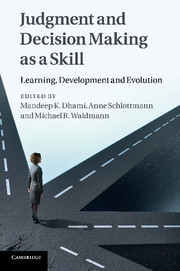Book contents
- Frontmatter
- Contents
- Figures
- Contributors
- Preface
- Acknowledgments
- Chapter cross-reference table
- Part I Evolutionary and neural bases of JDM
- Part II Developmental approaches to JDM
- Part III Learning JDM
- Part IV Improving and aiding JDM
- 9 Improving judgment and decision making through communication and representation
- 10 Aiding judgment and decision making
- Conclusion
- Index
- References
9 - Improving judgment and decision making through communication and representation
Published online by Cambridge University Press: 05 December 2011
- Frontmatter
- Contents
- Figures
- Contributors
- Preface
- Acknowledgments
- Chapter cross-reference table
- Part I Evolutionary and neural bases of JDM
- Part II Developmental approaches to JDM
- Part III Learning JDM
- Part IV Improving and aiding JDM
- 9 Improving judgment and decision making through communication and representation
- 10 Aiding judgment and decision making
- Conclusion
- Index
- References
Summary
Introduction
Careful attention to ways in which information is communicated and represented can have a significant impact on what decisions will be taken, in a way that has implications for many different professions. For example, journalists can adopt strategies for reporting disasters that facilitate causal analysis and coping in the public, or methods for representing statistical data that enable the public to properly evaluate the validity of politicians’ claims. Doctors can adopt ways of talking about uncertain treatment outcomes that will either encourage or discourage a course of action by a patient. Science teachers and statisticians can adopt graphical formats that enable complex relationships to be better understood by students and the general public. Indeed, as we will show, improving the communication and representation of information that will serve as input into a decision-making process can act as a powerful “scaffold” for optimizing human decision making.
Effective design of communication with the human decision maker depends on the characteristics of the communication channel used (spoken language, verbal text, graphical representation, etc.), and of the information-processing abilities of the recipient. We begin by noting several general features of human communication and information processing that condition the way communications should be designed, before moving on to note some particular ones. We then proceed to give examples that illustrate the importance of taking these features into account. After that, we will demonstrate how the way information is communicated can have a strong impact on judgments about causality; especially in designing external representations such as graphs, one has options about what and how much information to put in, and what to make salient. The issue of external representation becomes even more important when communicating about probabilities, which we will focus on afterwards. The general idea advanced in this chapter is that appropriate ways of communication can be used as a “scaffold” to optimize judgment and decision making: communicators can help decision makers. We will give examples of scaffolding throughout the chapter and will summarize the most important recommendations at the end of it.
- Type
- Chapter
- Information
- Judgment and Decision Making as a SkillLearning, Development and Evolution, pp. 229 - 258Publisher: Cambridge University PressPrint publication year: 2011
References
- 1
- Cited by



